The brush-type belt cleaners market is expected to grow from USD 53 million in 2025 to USD 68.6 million by 2035, supported by increasing focus on conveyor performance reliability and contamination control. In the first half of the forecast period, the market reaches approximately USD 60.3 million by 2030, adding USD 7.3 million or 46.7 percent of total growth, driven by rising conveyor usage in bulk handling, packaged goods transport, and continuous production environments. Brush-type cleaners are being adopted to reduce carryback, minimize belt wear, and improve operational consistency, especially in sectors where hygiene, product purity, and equipment uptime are critical performance priorities.
In the second half of the forecast period (2030–2035), the market is expected to grow from USD 60.3 million to USD 68.6 million, contributing USD 8.3 million, or 53.3 percent of decade growth. Growth dynamics during this phase are linked to automation of conveyor maintenance, where brush cleaners integrate with tensioning systems, rotation sensors, and maintenance alerts to support predictive servicing and reduce manual cleaning intervals. Food processing, grain handling, fertilizer production, and packaging facilities are emphasizing low-abrasion bristle formulations, corrosion-resistant frames, and easy-access mounting designs. Suppliers offering custom brush geometries, higher wear-life polymer fibers, and compatibility with high-speed or wet-washdown conveyors are positioned to gain competitive advantage as production environments prioritize sustained cleanliness, reduced downtime, and improved material flow efficiency.
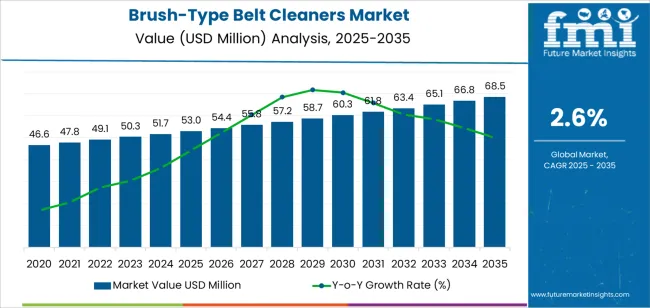
The latter half (2030-2035) will witness sustained growth from USD 60.3 million to USD 68.6 million, representing an addition of USD 8.3 million or 53.3% of the decade's expansion. This period will be defined by mass market penetration of specialized cleaner designs, integration with comprehensive conveyor management platforms, and seamless compatibility with existing material handling infrastructure. The market trajectory signals fundamental shifts in how industrial operations approach conveyor maintenance optimization and cleaning quality management, with participants positioned to benefit from sustained demand across multiple cleaner types and application segments.
The brush-type belt cleaners market demonstrates distinct growth phases with varying market characteristics and competitive dynamics. Between 2025 and 2030, the market progresses through its technology adoption phase, expanding from USD 53 million to USD 60.3 million with steady annual increments averaging 2.6% growth. This period showcases the transition from basic cleaning formulations to advanced primary belt cleaner systems with enhanced maintenance capabilities and integrated durability systems becoming mainstream features.
The 2025-2030 phase adds USD 7.3 million to market value, representing 46.7% of total decade expansion. Market maturation factors include standardization of conveyor maintenance and material handling protocols, declining component costs for specialized brush formulations, and increasing industry awareness of automated cleaning benefits reaching optimal maintenance effectiveness in food processing and agricultural applications. Competitive landscape evolution during this period features established manufacturers like Flexco and Martin Engineering expanding their belt cleaner portfolios while specialty manufacturers focus on advanced brush development and enhanced cleaning capabilities.
From 2030 to 2035, market dynamics shift toward advanced maintenance integration and global industrial expansion, with growth continuing from USD 60.3 million to USD 68.6 million, adding USD 8.3 million or 53.3% of total expansion. This phase transition centers on specialized cleaner type systems, integration with automated maintenance networks, and deployment across diverse food processing and recycling scenarios, becoming standard rather than specialized applications. The competitive environment matures with focus shifting from basic cleaning capability to comprehensive maintenance optimization systems and integration with conveyor monitoring platforms.
| Metric | Value |
|---|---|
| Market Value (2025) | USD 53 million |
| Market Forecast (2035) | USD 68.6 million |
| Growth Rate | 2.6% CAGR |
| Leading Technology | Primary Belt Cleaners Type |
| Primary Application | Food Processing Application Segment |
The market demonstrates strong fundamentals with primary belt cleaner systems capturing a dominant share through advanced cleaning efficiency and maintenance optimization capabilities. Food processing applications drive primary demand, supported by increasing conveyor operations and automated maintenance technology requirements. Geographic expansion remains concentrated in developed markets with established material handling infrastructure, while emerging economies show accelerating adoption rates driven by industrial facility expansion and rising hygiene standards.
Market expansion rests on three fundamental shifts driving adoption across the food processing, agricultural, and recycling sectors. First, conveyor maintenance demand creates compelling operational advantages through brush-type belt cleaners that provide immediate material removal and belt protection without compromising operational continuity, enabling facilities to meet stringent hygiene standards while maintaining production productivity and reducing belt wear. Second, material handling modernization accelerates as industrial operations worldwide seek advanced cleaning systems that complement traditional maintenance processes, enabling precise material removal and quality control that align with industry standards and safety regulations.
Third, operational efficiency enhancement drives adoption from food processors and agricultural facilities requiring effective cleaning solutions that maximize belt longevity while maintaining operational productivity during material transport and processing operations. Growth faces headwinds from maintenance cost challenges that vary across cleaner suppliers regarding the pricing of advanced brush systems and replacement components, which may limit adoption in cost-sensitive environments. Technical limitations also persist regarding brush wear rates and material compatibility concerns that may reduce effectiveness in abrasive material handling and harsh operating scenarios, which affect cleaning performance and maintenance requirements.
The brush-type belt cleaners market represents a specialized yet critical maintenance opportunity driven by expanding global conveyor operations, material handling modernization, and the need for superior cleaning effectiveness in diverse industrial applications. As facility operators worldwide seek to achieve optimal belt cleanliness, reduce material carryback, and integrate advanced cleaning systems with automated platforms, brush-type belt cleaners are evolving from basic maintenance tools to sophisticated cleaning solutions ensuring operational efficiency and hygiene leadership.
The market's growth trajectory from USD 53 million in 2025 to USD 68.6 million by 2035 at a 2.6% CAGR reflects fundamental shifts in industrial maintenance requirements and conveyor optimization. Geographic expansion opportunities are particularly pronounced in Asia Pacific markets, while the dominance of primary belt cleaner systems and food processing applications provides clear strategic focus areas.
Strengthening the dominant primary belt cleaners segment through enhanced brush technology, superior material removal, and automated tensioning systems. This pathway focuses on optimizing cleaning efficiency, improving belt protection, extending operational effectiveness to optimal maintenance rates, and developing specialized formulations for diverse applications. Market leadership consolidation through advanced brush engineering and automated maintenance integration enables premium positioning while defending competitive advantages against alternative cleaning methods. Expected revenue pool: USD 5.5-7.5 million
Rapid food processing and material handling growth across Asia Pacific creates substantial expansion opportunities through local manufacturing capabilities and technology partnership programs. Growing industrial investment and government food safety initiatives drive sustained demand for advanced belt cleaner systems. Localization strategies reduce import costs, enable faster technical support, and position companies advantageously for procurement programs while accessing growing domestic markets. Expected revenue pool: USD 4.5-6.2 million
Expansion within the dominant food processing segment (estimated 40% market share) through specialized cleaner designs addressing sanitary standards and high-throughput production requirements. This pathway encompasses automated cleaning systems, hygiene compliance integration, and compatibility with diverse conveyor processes. Premium positioning reflects superior material removal and comprehensive safety compliance supporting modern food processing operations. Expected revenue pool: USD 3.8-5.2 million
Strategic expansion into agriculture applications (estimated 30% market share) requires enhanced durability capabilities and specialized cleaner formulations addressing agricultural operational requirements. This pathway addresses grain handling, crop processing, and heavy-duty cleaning designs with advanced brush engineering for demanding agricultural standards. Premium pricing reflects specialized application requirements and extended durability standards. Expected revenue pool: USD 3.2-4.4 million
Development of specialized belt cleaner formulations for recycling applications (estimated 15% share) and logistics operations (10%), addressing specific material handling requirements and niche cleaning demands. This pathway encompasses waste processing workflows, distribution center operations, and cost-effective alternatives for emerging industrial segments. Technology differentiation through proprietary brush designs enables diversified revenue streams while reducing dependency on single application platforms. Expected revenue pool: USD 2.8-3.8 million
Expansion of secondary belt cleaners segment (estimated 35% market share) through enhanced residual cleaning, premium maintenance accuracy, and specialized fine material removal requirements. This pathway encompasses secondary cleaning applications, polishing operations, and specialty formulations requiring superior brush characteristics. Market development through advanced brush engineering enables differentiated positioning while accessing premium markets requiring highest-precision cleaning solutions. Expected revenue pool: USD 2.4-3.3 million
Development of environmentally superior belt cleaner formulations addressing regulatory compliance and sustainability requirements across food processing and agricultural applications. This pathway encompasses recyclable brush materials, sustainable manufacturing processes, and comprehensive ecological documentation. Premium positioning reflects environmental leadership and sustainability expertise while enabling access to environmentally-focused procurement programs and sustainability-driven industrial partnerships. Expected revenue pool: USD 2-2.8 million
Primary Classification: The market segments by cleaner type into Primary Belt Cleaners, Secondary Belt Cleaners, and Other categories, representing the evolution from basic cleaning tools to specialized maintenance solutions for comprehensive conveyor optimization.
Secondary Classification: Application segmentation divides the market into Food Processing, Agriculture, Recycling, Logistics/Warehousing, and Others sectors, reflecting distinct requirements for cleaning intensity, hygiene standards, and maintenance frequency.
Regional Classification: Geographic distribution covers Asia Pacific, Europe, North America, and other regions, with developed markets leading adoption while emerging economies show accelerating growth patterns driven by industrial facility expansion programs.
The segmentation structure reveals technology progression from standard brush-based formulations toward specialized cleaning systems with enhanced durability and maintenance capabilities, while application diversity spans from food processing to specialized agricultural and recycling applications requiring precise cleaner solutions.
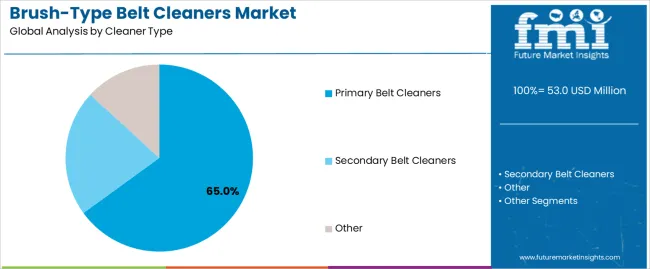
Market Position: Primary belt cleaner systems command the leading position in the Brush-Type Belt Cleaners market with approximately 65% market share through advanced cleaning technology, including superior material removal, effective belt protection capability, and maintenance optimization that enable facilities to achieve optimal conveyor performance across diverse food processing and industrial environments.
Value Drivers: The segment benefits from operator preference for reliable cleaning systems that provide consistent material removal, reduced belt wear, and operational efficiency without requiring significant infrastructure modifications. Advanced brush features enable automated tensioning, cleaning consistency, and integration with existing conveyor equipment, where maintenance reliability and cleaning effectiveness represent critical operational requirements.
Competitive Advantages: Primary belt cleaner systems differentiate through proven cleaning accuracy, consistent maintenance performance, and integration with automated conveyor systems that enhance operational effectiveness while maintaining optimal quality suitable for diverse industrial applications.
Key market characteristics:
Secondary belt cleaner systems maintain specialized maintenance positioning in the Brush-Type Belt Cleaners market due to their enhanced cleaning properties and residual material removal advantages. These systems appeal to facilities requiring sophisticated cleaning capabilities with superior precision for specialized fine material applications. Market adoption is driven by food processing expansion, emphasizing high-hygiene cleaning solutions and maintenance excellence through optimized secondary cleaning systems while maintaining comprehensive operational capabilities.
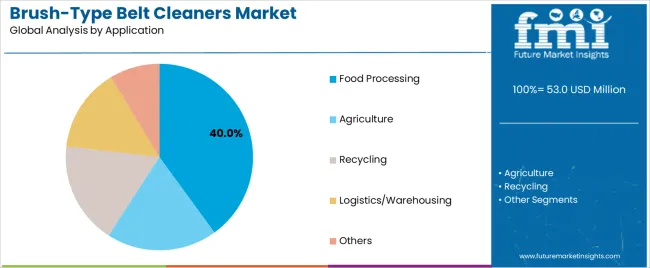
Market Context: Food processing applications dominate the Brush-Type Belt Cleaners market with approximately 40% market share due to widespread adoption of hygienic cleaning systems and increasing focus on material removal, sanitation compliance, and quality management applications that minimize contamination risks while maintaining food safety standards.
Appeal Factors: Food processors prioritize cleaning reliability, hygiene consistency, and integration with existing conveyor infrastructure that enables coordinated cleaner deployment across multiple production lines. The segment benefits from substantial food industry investment and modernization programs that emphasize the acquisition of belt cleaners for sanitation control and operational efficiency applications.
Growth Drivers: Food processing facility expansion programs incorporate brush-type belt cleaners as standard maintenance equipment for production operations, while packaged food growth increases demand for sanitation capabilities that comply with food safety standards and minimize product waste.
Market Challenges: Varying food industry standards and processing environment differences may limit cleaner standardization across different production facilities or operational scenarios.
Application dynamics include:
Agriculture applications capture approximately 30% market share through specialized cleaning requirements in grain handling facilities, crop processing operations, and agricultural material transport applications. These facilities demand robust cleaner systems capable of handling abrasive materials while providing effective cleaning and durable operational capabilities.
Recycling applications account for approximately 15% market share, logistics and warehousing operations capture 10%, while other segments represent 5%, including mining material handling, manufacturing conveyor systems, and specialty industrial applications requiring belt cleaner capabilities for maintenance optimization and operational compliance.
Growth Accelerators: Industrial facility modernization drives primary adoption as brush-type belt cleaners provide superior material removal capabilities that enable operations to meet stringent hygiene standards without excessive maintenance costs, supporting production operations and facility missions that require effective conveyor cleaning applications. Maintenance automation infrastructure demand accelerates market expansion as facilities seek effective cleaning systems that minimize manual intervention while maintaining operational effectiveness during material transport and processing scenarios. Industrial sector investment increases worldwide, creating sustained demand for advanced cleaning systems that complement traditional maintenance processes and provide operational efficiency in competitive markets.
Growth Inhibitors: Component replacement cost challenges vary across cleaner suppliers regarding the pricing of advanced brush systems and specialty materials, which may limit operational flexibility and market penetration in regions with constrained maintenance budgets or cost-sensitive facility operations. Technical performance limitations persist regarding brush wear rates and material compatibility concerns that may reduce effectiveness in abrasive material handling, harsh environmental conditions, or facilities with diverse material types, affecting cleaning reliability and maintenance requirements. Market fragmentation across multiple industry standards and conveyor configurations creates compatibility concerns between different cleaner suppliers and existing material handling infrastructure.
Market Evolution Patterns: Adoption accelerates in food processing and agricultural sectors where hygiene compliance justifies cleaner investment costs, with geographic concentration in developed markets transitioning toward mainstream adoption in emerging economies driven by industrial facility expansion and safety awareness. Technology development focuses on enhanced brush materials, improved durability integration, and compatibility with automated maintenance systems that optimize cleaning performance and operational effectiveness. The market could face disruption if alternative cleaning technologies or non-contact innovations significantly limit the deployment of brush-type cleaners in conveyor applications, though brush cleaners' unique combination of effective material removal, belt protection, and cost-effectiveness continues to make them preferred in industrial material handling applications.
The Brush-Type Belt Cleaners market demonstrates varied regional dynamics with Growth Leaders including China (3.5% CAGR) and India (3.2% CAGR) driving expansion through industrial facility capacity additions and manufacturing modernization programs. Steady Performers encompass Germany (2.9% CAGR), Brazil (2.7% CAGR), and United States (2.4% CAGR), benefiting from established food processing industries and advanced maintenance adoption. Mature Markets feature United Kingdom (2.2% CAGR) and Japan (1.9% CAGR), where specialized industrial applications and quality maintenance integration support consistent growth patterns.
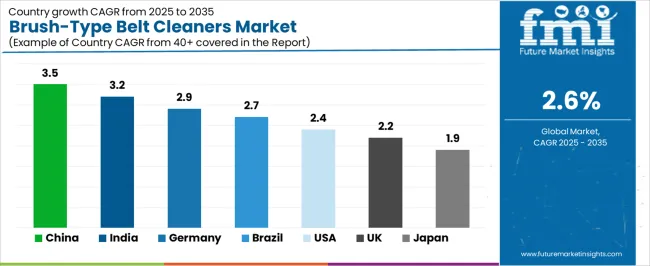
| Country | CAGR (2025-2035) |
|---|---|
| China | 3.5% |
| India | 3.2% |
| Germany | 2.9% |
| Brazil | 2.7% |
| United States | 2.4% |
| United Kingdom | 2.2% |
| Japan | 1.9% |
Regional synthesis reveals Asia Pacific markets leading adoption through industrial facility expansion and material handling infrastructure development, while European countries maintain steady expansion supported by maintenance technology advancement and hygiene standardization requirements. North American markets show moderate growth driven by food processing applications and maintenance integration trends.
The Chinese market emphasizes advanced cleaning features, including precision material removal control and integration with comprehensive conveyor management platforms that manage maintenance quality, operational optimization, and cleaning applications through unified monitoring systems. The country demonstrates strong growth at 3.5% CAGR, driven by industrial facility modernization, manufacturing infrastructure initiatives, and emerging food processing development that support belt cleaner integration. Chinese industrial operations prioritize operational effectiveness with brush-type belt cleaners delivering consistent maintenance performance through advanced cleaning capabilities and system adaptation features.
Technology deployment channels include major food processors, specialized maintenance equipment distributors, and industrial procurement programs that support professional applications for complex conveyor cleaning and material handling applications. Conveyor system integration capabilities with established manufacturing platforms expand market appeal across diverse operational requirements seeking cleaning efficiency and maintenance benefits. The expanding manufacturing base and accelerating food processing market create sustained demand, while innovative applications in recycling facilities and logistics centers open new growth avenues.
Performance Metrics:
Germany's advanced industrial market demonstrates sophisticated belt cleaner deployment with documented operational effectiveness in food processing applications and manufacturing facilities through integration with existing conveyor systems and maintenance infrastructure. The country leverages engineering expertise in material handling technology and maintenance systems integration to maintain strong growth at 2.9% CAGR. Industrial centers, including Frankfurt, Munich, and Hamburg, showcase premium installations where belt cleaner systems integrate with comprehensive maintenance platforms and quality management systems to optimize conveyor operations and cleaning effectiveness.
German industrial operations prioritize system reliability and hygiene compliance in cleaner development, creating demand for certified cleaning systems with advanced features, including automated tensioning and maintenance monitoring integration. The market benefits from established food processing infrastructure and commitment to invest in advanced maintenance technologies that provide long-term operational benefits and compliance with EU hygiene and safety standards.
Market Intelligence Brief:

The USA brush-type belt cleaners market demonstrates sophisticated deployment across food processing applications with documented effectiveness in industrial facilities and agricultural operations through integration with comprehensive maintenance management systems and safety infrastructure. The country leverages advanced industrial capabilities in equipment innovation and operational optimization technologies to maintain moderate growth at 2.4% CAGR. Industrial centers, including Chicago, Atlanta, and Los Angeles, showcase premium installations where belt cleaner systems integrate with comprehensive conveyor platforms and automated maintenance networks to optimize cleaning accuracy and operational effectiveness.
American industrial operations prioritize maintenance reliability and safety compliance in cleaner development, creating demand for certified systems with advanced features, including automated monitoring and predictive maintenance integration. The market benefits from established food processing infrastructure and willingness to invest in advanced maintenance technologies that provide long-term operational benefits and compliance with USDA and OSHA standards.
Market Intelligence Brief:
The UK brush-type belt cleaners market demonstrates advanced quality deployment with documented operational effectiveness in food processing applications and industrial facilities through integration with existing maintenance systems and safety infrastructure. The country leverages industrial expertise in maintenance quality and conveyor systems integration to maintain steady growth at 2.2% CAGR. Industrial centers, including London, Manchester, and Birmingham, showcase quality installations where belt cleaner systems integrate with comprehensive maintenance platforms and safety management systems to optimize hygiene compliance and cleaning effectiveness.
British industrial operations prioritize system reliability and regulatory compliance in cleaner development, creating demand for certified cleaning systems with advanced features, including automated maintenance monitoring and safety reporting. The market benefits from established food processing infrastructure and commitment to invest in quality maintenance technologies that provide long-term operational benefits and compliance with UK and EU safety standards. Food processing applications, manufacturing operations, and agricultural facilities drive diversified demand across multiple industrial segments.
Strategic Market Indicators:
India's brush-type belt cleaners market demonstrates rapid expansion deployment with documented operational effectiveness in food processing applications and industrial facilities through integration with emerging manufacturing systems and maintenance development infrastructure. The country leverages growing industrial capabilities in material handling and maintenance systems integration to achieve high growth at 3.2% CAGR. Industrial centers, including Mumbai, Delhi, and Pune, showcase expanding installations where belt cleaner systems integrate with comprehensive conveyor platforms and manufacturing networks to optimize market penetration and cleaning effectiveness.
Indian industrial operations prioritize cost-effectiveness and operational standards in cleaner development, creating demand for reliable cleaning systems with essential features, including basic automated tensioning and maintenance monitoring systems. The market benefits from expanding food processing infrastructure and willingness to invest in international-standard maintenance technologies that provide operational efficiency and compliance with Indian safety standards.
Market Intelligence Brief:
Brazil's brush-type belt cleaners market demonstrates consistent expansion deployment with documented operational effectiveness in agricultural applications and food processing facilities through integration with developing industrial systems and maintenance infrastructure. The country leverages agricultural capabilities in material handling and processing operations to maintain steady growth at 2.7% CAGR. Industrial centers, including São Paulo, Curitiba, and Porto Alegre, showcase growing installations where belt cleaner systems integrate with conveyor platforms and agricultural processing networks to optimize maintenance coverage and cleaning effectiveness.
Brazilian industrial operations prioritize system reliability and operational efficiency in cleaner development, creating demand for robust cleaning systems with practical features, including simplified maintenance and technical support. The market benefits from expanding agricultural processing infrastructure and industry investment in maintenance technologies that provide operational benefits and compliance with Brazilian safety standards.
Market Intelligence Brief:
Japan's brush-type belt cleaners market demonstrates precision deployment with documented operational effectiveness in food processing applications and manufacturing facilities through integration with advanced conveyor systems and quality control infrastructure. The country leverages engineering excellence in precision maintenance and material handling systems integration to maintain steady growth at 1.9% CAGR. Industrial centers, including Tokyo, Osaka, and Nagoya, showcase premium installations where belt cleaner systems integrate with comprehensive quality platforms and maintenance management systems to optimize cleaning excellence and operational effectiveness.
Japanese industrial operations prioritize system precision and maintenance excellence in cleaner development, creating demand for ultra-reliable cleaning systems with advanced features, including micro-precision tensioning and comprehensive quality integration systems. The market benefits from established food processing infrastructure and commitment to invest in highest-quality maintenance technologies that provide superior operational performance and compliance with stringent Japanese safety standards.
Strategic Market Indicators:

The Brush-Type Belt Cleaners market in Europe is projected to grow substantially over the forecast period, with Germany expected to maintain its leadership position with a significant market share supported by its advanced food processing infrastructure and major industrial facilities in Frankfurt and Munich. The United Kingdom follows with strong market presence, driven by comprehensive facility modernization programs and food safety initiatives. France holds substantial market share through specialized food processing activities, agricultural operations, and industrial manufacturing. Italy commands notable market presence through strong food production and packaging projects. Spain accounts for growing market share aided by agricultural expansion and food processing adoption. The Netherlands maintains steady share driven by specialty food operations and logistics demand. The Rest of Europe region is anticipated to show steady adoption, reflecting consistent growth in Nordic countries, industrial expansion in Central European markets, and facility modernization upgrades across Eastern European food processing operations.
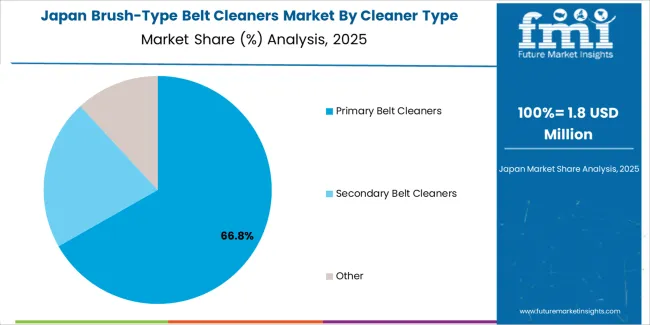
In Japan, the Brush-Type Belt Cleaners market prioritizes primary belt cleaner systems, which capture the dominant share of food processing and manufacturing installations due to their proven features, including reliable cleaning optimization and seamless integration with existing conveyor infrastructure. Japanese industrial operations emphasize reliability, precision, and long-term operational excellence, creating demand for primary belt cleaner systems that provide consistent maintenance capabilities and superior cleaning performance based on facility requirements and hygiene standards. Secondary belt cleaners maintain secondary positions primarily in specialized food processing applications and high-precision cleaning installations where advanced maintenance functionality meets operational requirements without compromising cleaning precision.
Market Characteristics:
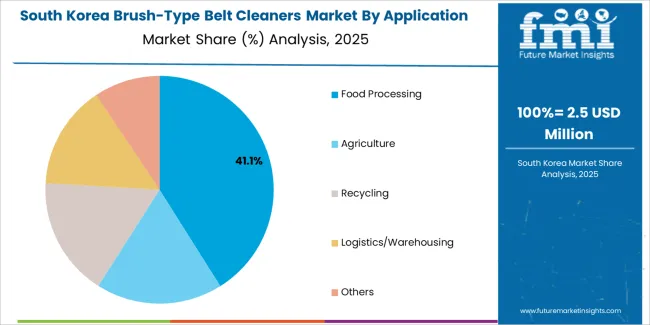
In South Korea, the market structure favors international equipment manufacturers, including Flexco, Martin Engineering, and GURTEC, which maintain dominant positions through comprehensive product portfolios and established industrial networks supporting both food processing maintenance and manufacturing facility installations. These providers offer integrated solutions combining advanced belt cleaner systems with professional technical services and ongoing replacement support that appeal to Korean facilities seeking reliable maintenance systems. Local equipment distributors and service providers capture moderate market share by providing localized support capabilities and competitive pricing for standard conveyor installations, while domestic manufacturers focus on specialized applications and cost-effective solutions tailored to Korean industrial market characteristics.
Channel Insights:

The Brush-Type Belt Cleaners market operates with moderate concentration, featuring approximately 12-15 meaningful participants, where leading companies control roughly 60-65% of the global market share through established industrial relationships and comprehensive maintenance equipment portfolios. Competition emphasizes advanced cleaning capabilities, durability reliability, and conveyor integration rather than price-based rivalry. The leading company, Flexco, commands approximately 32% market share through its extensive belt cleaner product line and global material handling presence.
Market Leaders encompass Flexco, Martin Engineering, and GURTEC, which maintain competitive advantages through extensive maintenance technology expertise, global industrial networks, and comprehensive conveyor integration capabilities that create customer loyalty and support premium pricing. These companies leverage decades of belt cleaning experience and ongoing innovation investments to develop advanced maintenance systems with precision material removal and durability features. Technology Innovators include InduTechnik, Argonics, and regional specialists, which compete through specialized cleaner technology focus and innovative maintenance capabilities that appeal to facilities seeking advanced cleaning solutions and operational optimization.
These companies differentiate through rapid product development cycles and specialized application focus. Regional Specialists feature equipment manufacturers focusing on specific geographic markets and specialized applications, including food-grade systems and integrated maintenance solutions. Market dynamics favor participants that combine reliable cleaning performance with advanced durability capabilities, including precision brush design and automatic tensioning integration features. Competitive pressure intensifies as traditional conveyor equipment suppliers expand into belt cleaning systems, while specialized maintenance companies challenge established players through innovative cleaning solutions and automated platforms targeting food processing and industrial facility segments.
| Item | Value |
|---|---|
| Quantitative Units | USD 53 million |
| Cleaner Type | Primary Belt Cleaners, Secondary Belt Cleaners, Other |
| Application | Food Processing, Agriculture, Recycling, Logistics/Warehousing, Others |
| Regions Covered | Asia Pacific, Europe, North America, Latin America, Middle East & Africa |
| Countries Covered | China, India, Germany, Brazil, United States, United Kingdom, Japan, and 20+ additional countries |
| Key Companies Profiled | Flexco, Martin Engineering, GURTEC, InduTechnik, Argonics, IPCO, Benetech, Luff Industries, JIMWAY, Airmatic Inc. |
| Additional Attributes | Dollar sales by cleaner type and application categories, regional adoption trends across Asia Pacific, Europe, and North America, competitive landscape with equipment manufacturers and industrial suppliers, facility preferences for durability and maintenance effectiveness, integration with conveyor platforms and quality monitoring systems, innovations in brush materials and cleaning excellence, and development of automated maintenance solutions with enhanced performance and operational optimization capabilities. |
The global brush-type belt cleaners market is estimated to be valued at USD 53.0 million in 2025.
The market size for the brush-type belt cleaners market is projected to reach USD 68.5 million by 2035.
The brush-type belt cleaners market is expected to grow at a 2.6% CAGR between 2025 and 2035.
The key product types in brush-type belt cleaners market are primary belt cleaners, secondary belt cleaners and other.
In terms of application, food processing segment to command 40.0% share in the brush-type belt cleaners market in 2025.






Full Research Suite comprises of:
Market outlook & trends analysis
Interviews & case studies
Strategic recommendations
Vendor profiles & capabilities analysis
5-year forecasts
8 regions and 60+ country-level data splits
Market segment data splits
12 months of continuous data updates
DELIVERED AS:
PDF EXCEL ONLINE
Belt Trainers Market Size and Share Forecast Outlook 2025 to 2035
Belt File Sander Market Size and Share Forecast Outlook 2025 to 2035
Belt Feeders Market Size and Share Forecast Outlook 2025 to 2035
Cross-Belt Sorters Market
Chamber Belt Vacuum Machine Market Analysis Size and Share Forecast Outlook 2025 to 2035
Packing Belt Market Insights - Growth & Forecast 2025 to 2035
Modular Belt Drive Market
Conveyor Belt Tracking Devices Market Size and Share Forecast Outlook 2025 to 2035
Conveyor Belt Market Size and Share Forecast Outlook 2025 to 2035
Conveyor Belt Materials Market
Ammunition Belt Market Size and Share Forecast Outlook 2025 to 2035
Automotive Belts Market Growth - Trends & Forecast 2025 to 2035
Blade-type Belt Cleaners Market Size and Share Forecast Outlook 2025 to 2035
Industrial V Belts Market Growth - Trends & Forecast 2025 to 2035
Conveyors and Belt Loaders Market Growth - Trends & Forecast 2025 to 2035
Automotive Seat Belts Market Size and Share Forecast Outlook 2025 to 2035
Rubber Conveyor Belt Market Size, Growth, and Forecast 2025 to 2035
Band File Sander Belts Market Size and Share Forecast Outlook 2025 to 2035
Automotive Timing Belt Market
Demand for Conveyor Belts in EU Size and Share Forecast Outlook 2025 to 2035

Thank you!
You will receive an email from our Business Development Manager. Please be sure to check your SPAM/JUNK folder too.
Chat With
MaRIA